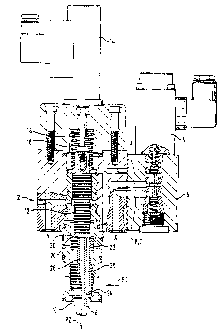Une partie des informations de ce site Web a été fournie par des sources externes. Le gouvernement du Canada n'assume aucune responsabilité concernant la précision, l'actualité ou la fiabilité des informations fournies par les sources externes. Les utilisateurs qui désirent employer cette information devraient consulter directement la source des informations. Le contenu fourni par les sources externes n'est pas assujetti aux exigences sur les langues officielles, la protection des renseignements personnels et l'accessibilité.
L'apparition de différences dans le texte et l'image des Revendications et de l'Abrégé dépend du moment auquel le document est publié. Les textes des Revendications et de l'Abrégé sont affichés :
| (12) Brevet: | (11) CA 2054367 |
|---|---|
| (54) Titre français: | SOUPAPE D'ETRANGLEMENT REGLABLE A DEPLACEMENT PROPORTIONNEL AVEC RETROACTION |
| (54) Titre anglais: | ADJUSTABLE PROPORTIONAL THROTTLE-VALVE WITH FEEDBACK |
| Statut: | Périmé et au-delà du délai pour l’annulation |
| (51) Classification internationale des brevets (CIB): |
|
|---|---|
| (72) Inventeurs : |
|
| (73) Titulaires : |
|
| (71) Demandeurs : |
|
| (74) Agent: | GOWLING WLG (CANADA) LLP |
| (74) Co-agent: | |
| (45) Délivré: | 2001-12-25 |
| (22) Date de dépôt: | 1991-10-28 |
| (41) Mise à la disponibilité du public: | 1992-05-01 |
| Requête d'examen: | 1998-08-24 |
| Licence disponible: | S.O. |
| Cédé au domaine public: | S.O. |
| (25) Langue des documents déposés: | Anglais |
| Traité de coopération en matière de brevets (PCT): | Non |
|---|
| (30) Données de priorité de la demande: | ||||||
|---|---|---|---|---|---|---|
|
The throttle-part of the valve comprises a two-way seat valve with a follow-up
throttle
piston. A differential guide piston allows to position the follow-up throttle
piston via an edge
control system. The differential guide piston is biased via a spring in a
pressure-spring
compartment in the direction of the closed position of the edge control
system. A proportional
directional control valve, which is actuated by a magnet, allows to pressurise
or depressurise the
pressure-spring compartment via a pilot line A, whilst the position of the
guide piston is
determined by an inductive displacement transducer.
Note : Les revendications sont présentées dans la langue officielle dans laquelle elles ont été soumises.
Note : Les descriptions sont présentées dans la langue officielle dans laquelle elles ont été soumises.

2024-08-01 : Dans le cadre de la transition vers les Brevets de nouvelle génération (BNG), la base de données sur les brevets canadiens (BDBC) contient désormais un Historique d'événement plus détaillé, qui reproduit le Journal des événements de notre nouvelle solution interne.
Veuillez noter que les événements débutant par « Inactive : » se réfèrent à des événements qui ne sont plus utilisés dans notre nouvelle solution interne.
Pour une meilleure compréhension de l'état de la demande ou brevet qui figure sur cette page, la rubrique Mise en garde , et les descriptions de Brevet , Historique d'événement , Taxes périodiques et Historique des paiements devraient être consultées.
| Description | Date |
|---|---|
| Le délai pour l'annulation est expiré | 2006-10-30 |
| Inactive : CIB de MCD | 2006-03-11 |
| Inactive : CIB de MCD | 2006-03-11 |
| Lettre envoyée | 2005-10-28 |
| Inactive : TME en retard traitée | 2002-10-31 |
| Accordé par délivrance | 2001-12-25 |
| Inactive : Page couverture publiée | 2001-12-24 |
| Inactive : Taxe finale reçue | 2001-09-25 |
| Préoctroi | 2001-09-25 |
| Un avis d'acceptation est envoyé | 2001-06-26 |
| Un avis d'acceptation est envoyé | 2001-06-26 |
| Lettre envoyée | 2001-06-26 |
| Inactive : Approuvée aux fins d'acceptation (AFA) | 2001-06-14 |
| Modification reçue - modification volontaire | 2001-03-14 |
| Inactive : Dem. de l'examinateur par.30(2) Règles | 2000-09-20 |
| Inactive : Dem. traitée sur TS dès date d'ent. journal | 1998-09-28 |
| Lettre envoyée | 1998-09-28 |
| Inactive : Renseign. sur l'état - Complets dès date d'ent. journ. | 1998-09-28 |
| Toutes les exigences pour l'examen - jugée conforme | 1998-08-24 |
| Exigences pour une requête d'examen - jugée conforme | 1998-08-24 |
| Demande publiée (accessible au public) | 1992-05-01 |
Il n'y a pas d'historique d'abandonnement
Le dernier paiement a été reçu le 2001-10-03
Avis : Si le paiement en totalité n'a pas été reçu au plus tard à la date indiquée, une taxe supplémentaire peut être imposée, soit une des taxes suivantes :
Veuillez vous référer à la page web des taxes sur les brevets de l'OPIC pour voir tous les montants actuels des taxes.
| Type de taxes | Anniversaire | Échéance | Date payée |
|---|---|---|---|
| TM (demande, 6e anniv.) - petite | 06 | 1997-10-28 | 1997-10-21 |
| Requête d'examen - petite | 1998-08-24 | ||
| TM (demande, 7e anniv.) - petite | 07 | 1998-10-28 | 1998-09-30 |
| TM (demande, 8e anniv.) - petite | 08 | 1999-10-28 | 1999-10-27 |
| TM (demande, 9e anniv.) - petite | 09 | 2000-10-30 | 2000-08-21 |
| Taxe finale - petite | 2001-09-25 | ||
| TM (demande, 10e anniv.) - petite | 10 | 2001-10-29 | 2001-10-03 |
| Annulation de la péremption réputée | 2003-10-28 | 2002-10-31 | |
| TM (brevet, 11e anniv.) - petite | 2002-10-28 | 2002-10-31 | |
| Annulation de la péremption réputée | 2003-10-28 | 2003-10-02 | |
| TM (brevet, 12e anniv.) - petite | 2003-10-28 | 2003-10-02 | |
| 2004-10-04 | |||
| TM (brevet, 13e anniv.) - petite | 2004-10-28 | 2004-10-04 |
Les titulaires actuels et antérieures au dossier sont affichés en ordre alphabétique.
| Titulaires actuels au dossier |
|---|
| HYDROLUX S.A.R.L. |
| Titulaires antérieures au dossier |
|---|
| HANS SCHWELM |